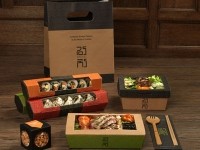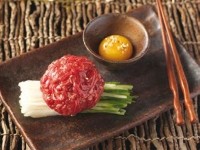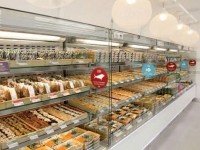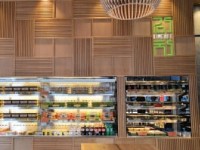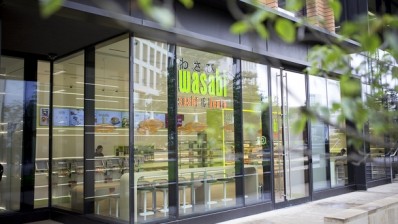Business Profile: Kimchee
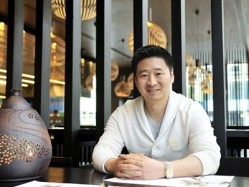
Dong Hyun Kim, aka Mr Kim, has proved a tricky man to pin down. To be fair he has been busy, extraordinarily so in fact, with last-minute business trips to New York and Milan and the opening of an all-new restaurant format on the Strand.
As we finally sit down to eat at Kimchee – the Korean-born restaurateur’s hugely successful Korean eaterie on London’s High Holborn – he looks remarkably tranquil, his demeanour contrasting sharply with the ambience of the restaurant, where 275-odd diners work their way through an array of freshly cooked Korean dishes.
Most of Kimchee’s customers would be surprised to learn that Hyun Kim is also behind London’s cheap and cheerful Wasabi sushi chain (see The Hyun Kim empire below). With 33 sites trading and another seven due by the end of the year, the format – which also offers a selection of hot dishes and salads – is one of the biggest players in the capital’s ‘food-to-go’ market, doing battle with the likes of Pret A Manger, EAT and arch-rival Itsu for the office-worker pound.
Hyun Kim attributes the incredible success of the Wasabi brand – launched in 2004, it now turns over £45m a year – to its individually wrapped, pick-and-mix approach to sushi, an idea he picked up while studying in Tokyo. “Western people are still apprehensive about raw fish. When I first arrived in London there were fewer sushi shops and the only thing on offer to take away were trays of mixed sushi. A selection will often include something a customer isn’t sure about, which will put them off the purchase. Selling individual pieces puts the customer in control,” he says.
Pick-and-mix sushi also creates an extremely accessible price-point, with Wasabi’s selection starting at £1 for two pieces of vegetarian hosomaki. Unsurprisingly, Hyun Kim has national ambitions for the format. August will see the launch of two branches at Land Securities’ Trinity Leeds development, a kiosk just outside and a larger outlet within. “Leeds is the test for the brand, if it does well we’ll look at Manchester and Birmingham. But we’re reasonably confident. It’s a great development and the city’s large student population is a huge plus for us.”
But before Wasabi goes north it will go west; some 3,500 miles in fact, with an opening in New York. “It’s been tricky,” says Hyun Kim of his first overseas project. “After six months of paperwork we’re finally at fit-out, then we’ve got the unions to contend with. We also have sites coming up in Paris and Dubai.”
Despite this flurry of international activity, the Hampstead-based Hyun Kim will continue to concentrate the majority of his efforts on the UK.
Food on the go
The project he is most preoccupied with at the moment is a food-to-go version of Kimchee, Kimchee To Go. Like Wasabi, the format can trade from Al (retail) premises as well as A3 restaurant sites. Although there are some major restrictions associated with A1 – most notably limits on seating and a ban on almost all ‘cooking’ apart from the heating up of pre-made dishes – securing sites is far easier, with greater availability and much lower premiums and rents. Much like Pret A Manger in the 1990s, the A1 loophole has allowed Wasabi to expand at pace in prime London locations, and Kimchee To Go will likely follow a similar path.
“A1 can be frustrating but we’re experienced now, we know how it works. It depends on the council – City of London and Islington are fine but Westminster is difficult – you’ll notice we have less seating and hot food in our West End branches. But other A1 specialists have the same issue with Westminster – even Starbucks,” says Hyun Kim.
A lack of suitable A3 sites is holding the Kimchee restaurant format from expansion. With the Holborn site turning over around £3m per year, this is clearly a source of significant frustration for Hyun Kim, who keeps losing suitable sites to much larger players, including Pizza Express and Gourmet Burger Kitchen.
As such the focus has shifted to Kimchee To Go, which in many ways is Hyun Kim’s most ambitious project to date. There’s no doubt Korean food is rapidly gaining momentum and is already an established part of the London foodie scene – bloggers have even been known to venture beyond Zone 6 to visit Korean restaurant hotspot New Malden, in south-west London – but from a mass-market perspective, it’s virtually unknown.
Yet Hyun Kim is quietly confident about the prospects of his homeland’s cuisine: “There is enormous potential. Korean food is healthy, aromatic and spicy and most of the ingredients used to prepare it are familiar. I believe it’s a far easier sell than sushi. People will be interested to try it as it has many similarities with better-established Asian cuisines.”
Initial signs indicate that his faith is well-placed. Considering its market positioning – the price-point is similar to Wasabi with spend per head anticipated to be in the region of £8 – the inaugural Kimchee To Go site has generated an impressive amount of interest with queues at peak times commonplace. The look of the site is more premium than Wasabi, with wood panelling and traditional Korean design elements.
True to its roots
The food offering has been cleverly designed to tie in with established food-to-go product categories; salad, wraps, dumplings, sushi, porridge, noodle soups and even Korean-style toasted sandwiches means most customers will find something familiar. During the opening, Hyun Kim spent 10 days in the kitchen, working with his almost exclusively Western team to ensure the dishes were as true to the source material as possible.
“Korean food is fairly complicated, the sauces and marinades in particular,” says Hyun Kim, who is no stranger to kitchen work, having spent six months cooking at the original Kimchee restaurant in Golders Green, north London.
As our conversation unfolds, it becomes clear that Hyun Kim is far from a typical multiple restaurant operator, and his route into the industry was even more unusual. Arriving in London with no experience at all in the hospitality sector (he had worked for Samsung’s corporate finance department in Korea), he spotted a gap in the market for both sushi and Korean food. Unable to secure any finance – “I went to four banks and each barely even looked at my business plan before turning me down,” – he opened a series of food stalls in Camden Market.
“That taught me a lot about food production and customer service, and generated enough funds for the first Wasabi.”
Since then, the business has expanded almost entirely organically, with minor help from HSBC. Very unusually, Hyun Kim is happy to go on record to rule out any private investor or private-equity involvement in either the Wasabi or Kimchee business: “The minute investors get involved you start to lose control, and that’s not me. A bank is only concerned with interest, it won’t stick its nose in your business or try and dictate what you do next. I’ve made some mistakes along the way, but I prefer to do things my own way.”
With nearly 50 units set to be trading before the year’s out, this policy of splendid isolation appears to be working just fine.
The Hyun Kim empire
Wasabi:
Launched in 2004, Wasabi Sushi & Bento has grown to become one of the biggest players in London’s frenetic ‘food-to-go’ market with 33 sites currently trading and seven more likely to open before the year is out. Although conceived to trade from A1 retail premises, roughly half the sites are A3. A1 sites usually have limited seating while A3 Wasabis are more restaurant-like in set-up – the group’s Paternoster Square unit has 97 covers, for example. The food offering majors on individual portions of plastic-wrapped sushi (from £1), sushi trays and hot dishes that draw influence from a range of Asian cuisines. Average spend per head is £6.95 and group turnover is approximately £45m, with 70 per cent of sales consumed off-site.
Kimchee:
Despite being seen as a relatively new format, Kimchee was actually born back in 2003 around the same time as Wasabi. Dong Hyun Kim launched a test site in Golders Green, north London, which he operated successfully until 2011 when he sold it to fund the opening of the 275-cover Kimchee on High Holborn. With a striking contemporary design, the second iteration of Kimchee owes more to Busaba Eathai and Hakkasan than Pret A Manger. The large menu comprises a ‘greatest hits’ of Korean cuisine, including yuk hwae (beef tartare with sliced pear and egg yolk), dolsot bibimbap (a hot bowl of rice with various toppings), hotpots and an array of grilled meat dishes. Turnover is clocked at an impressive £56k per week, with an average spend of £16 per head. Hyun Kim is actively looking for roomy A3 sites but several
more Kimchee To Go sites are expected to open before a second eat-in Kimchee.
Kimchee To Go:
Dong Hyun Kim’s newest format launched in April on the Strand with a second site set to open on New Oxford Street early this month. In truth, the offering bears little resemblance to its A3 big brother: Kimchee To Go is Korean food for London workers, with all office lunch staples present and correct, including wraps, salads (such as a cold version of bibimbap) and kimbap, a Korean take on sushi. Noodle soups and dosirak boxes – stir-fry-like dishes flanked by a selection of lighter Korean tapas – make up the bulk of the hot food offering. Unlike Wasabi, there’s a major attempt to engage with the breakfast market, with Korean takes on toasted sandwiches and porridge – and a wide selection of teas. Hyun Kim plans to have 15 Kimchee branches trading by 2015, with the majority likely to be under the Kimchee To Go banner.
This article first appeared in the May 2013 edition of Restaurant magazine. View the digital edition here.
